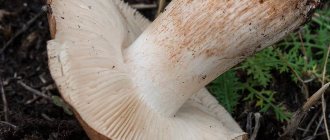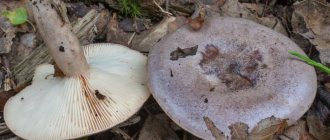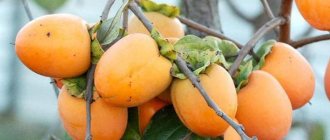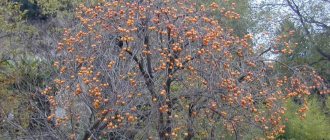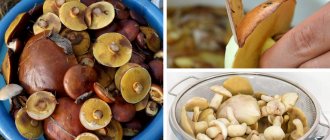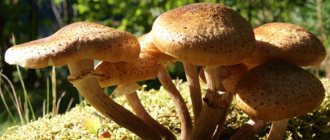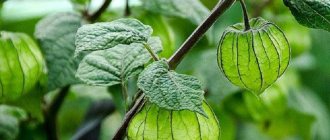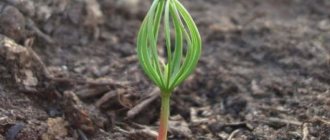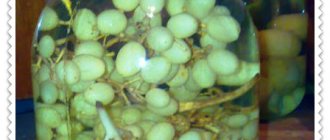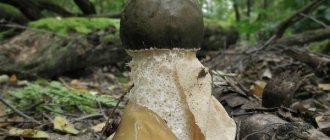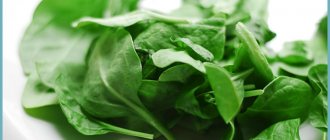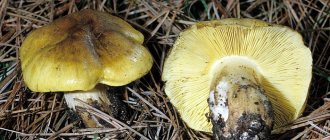Photos and descriptions of the poplar row show a simple-looking and very productive mushroom, which is found in any place where poplars grow en masse. Proper preparation provides the product with an exquisite taste, which gourmets compare to truffle. Knowing where to look and how to properly process poplar mushrooms, you can get an unlimited amount of delicious delicacy and prepare a treat for the winter.
What does the poplar row mushroom look like?
Podtopolnik is the popular name for poplar (poplar) row, a common mushroom from the extensive family of rows. In different areas, the culture received the names sandpiper, zabaluika, and frost in accordance with its development characteristics and favorite habitats. The prefix “row” in the name characterizes the tendency towards group growth. Mushrooms are always found in large families arranged in rows or circles around poplar trees.
Young specimens have a convex cap, close to hemispherical. Then it grows and unfolds, reaching from 9 to 18 cm in diameter. The adult cap becomes flat; in older specimens, it becomes depressed in the center. The edges are uneven, sometimes wavy or cracked. The color of the cap is from yellow to red-brown, characterized by the obligatory presence of pink shades and fades towards the edges. The surface is smooth, without scales.
The plates under the cap of the row are pinkish or snow-white, darkening over time, acquiring a brown tint. The leg of the poplar variety is thick (up to 5 cm in diameter), fleshy, creamy white, and slightly widens towards the base. An adult mushroom reaches 8 cm in height.
The peculiarity of the poplar species is the ability to go through the entire development cycle without appearing above the soil surface. Often the mushrooms only lift the turf, remaining in the ground along with the caps. Covered with fallen leaves, the families reveal themselves only as loose hummocks under the trees. Having found one mushroom, you can confidently search around - poplar rows never grow alone.
Poplar row (Tricholoma populinum)
Sandstone
The poplar row mushroom belongs to the lamellar mushrooms, which means that it reproduces by spores located in its plates.
Description
When young, its plates are white or cream-colored, frequent and thin. And, as the mushroom grows, they change their color to pinkish-brownish.
His hat at the beginning has a semi-spherical and slightly convex shape, with thin edges tucked inward, then it straightens and bends slightly, becomes fleshy, in the rain - slightly slippery, pinkish-brown in color. The diameter of the cap varies from 6 to 12 cm. Under the skin of the cap, the flesh is slightly reddish.
The stem of the poplar row is of medium size, rather fleshy, cylindrical in shape and solid inside, with a flaky-scaly coating, fibrous and smooth, pinkish-white or pinkish-brown in color, covered with brown spots when pressed.
The flesh of the mushroom is fleshy, soft, white, brownish under the skin, with a floury taste.
Spreading
Poplar row grows from August to October in large groups (entire ridges) under poplars, deciduous forests with a predominance of aspen, and can be found in plantings along roads and in parks. Distributed in the European part of Russia and Siberia. The mushroom has a pleasant aroma of fresh flour.
The poplar row mushroom got its name for its ability to grow under poplars and in close proximity to them, during the autumn leaf fall. Poplar row, at a young age, is a little similar to crowded row in color and shape, but, unlike it, it is much larger than it in size and has a slightly bitter taste due to the fact that it grows in such conditions that the cut mushroom is almost completely covered with sand or small debris. It can also be confused with the poisonous tiger rower. But they are distinguished by two main features. Firstly, poplar row always grows in large groups and, secondly, it always grows close to poplars.
Edibility
In terms of its taste and consumer qualities, the poplar row belongs to the edible mushrooms of the fourth category.
Poplar row is a completely edible mushroom, but only after it has been washed, soaked and boiled to remove bitterness. Poplar row grows in deciduous plantings under poplars, well covered with fallen leaves, always in large colonies. Poplar rows are common wherever poplars grow - these are the territories of North America and Canada, Western and Eastern Europe, Central Asia, as well as central and southern Russia, the Urals, Siberia and the Far East. Its main growth period begins during the autumn leaf fall season, around the end of August, and ends at the end of October.
Poplar row is eaten exclusively in salted or pickled form after thorough washing, soaking and boiling.
Video about the poplar row mushroom:
Photo of the poplar row
from questions in recognition:
Where does the poplar row grow?
Poplars grow in large families and can appear around poplars in parks, forest belts, along roads, ravines, and near ponds. In just a few years, the population can occupy an entire clearing near the trees. The poplar species prefers dry, loose soil; most often, their mass distribution is observed on sandy soils.
The natural habitat of poplar rows is North America, Canada, all of Europe and Central Asia. Rows grow in Ukraine, Belarus, in the south of Russia, in the middle zone to the Far East.
Description of the mushrooms
The Oryadovaceae/Tricholomaceae family is so named not for its “love” for geometrically correct structures, but for its crowded growth. In one place, mushroom pickers sometimes collect 1.5 buckets. Poplar row is no exception in this regard.
Its Latin name is Tricholoma populinum from the genus Tricholoma. When determining a poplar row from a photo and description, it is better to rely on Latin. In regions, the mushroom is called differently:
- floodplain;
- poplar;
- subtopolevik;
- poplar row;
- sandstone;
- sandpiper;
- spoilers;
- frosties.
These are the same type of poplar rows, and not different mushrooms. But other representatives of the Tricholomaceae family can also be called sandpipers and sandpipers. The fruiting bodies of tricholomas are often “hidden” underground. Hence such strange names.
Attention! Podtopolniks always grow and always grow near poplars. But rows, including poisonous varieties, can be found throughout coniferous and deciduous forests
The real underwater plant belongs to the group of conditionally edible
But rowers, including poisonous varieties, can be found throughout coniferous and deciduous forests. The real underwater plant belongs to the group of conditionally edible ones.
What do flood mushrooms look like?
Often poplar rows look like small mounds of earth. Some fans even look for them using rubber shoes: a hard lump can be clearly felt under the thin sole. Medium-sized leg: 2-10 cm. Most often about 4 cm high. Diameter (2-4 cm) is almost the same along the entire length. Only at the mycelium itself the stalk barely noticeably thickens.
Comment! A variant with a thick stem, similar to a highly elongated drop, is possible.
Inside the leg is dense, without cavities, fleshy. The consistency is dry. The color is pinkish-brown (old) or pinkish-white (young). The surface can be smooth or fibrous. Covered with flocculent scales. When pressure is applied, brown spots remain on the stem.
The young topiary has a hemisphere-shaped cap. The edges are thin and curved inwards towards the stem. As it grows, the cap straightens, becomes fleshy and slightly curved. The skin is pinkish-brown. In rainy weather it becomes slippery. Cap diameter 6-12 cm.
The hymenophore of a young tortoiseshell is white; with age, the plates become pinkish-brown. The flesh is white, but under the skin of the cap it has a brownish color. At the break it turns brown. Opinions about the smell vary. Reference books usually indicate the pleasant aroma of fresh flour. But some mushroom pickers believe that the poplar row smells of soap. In fact, there is a high probability that poplar is confused with soap. The latter really smells like fruit soap.
Comment! Regarding the taste, opinions are the same: either mealy or soapy.
And the reason for the discrepancies, apparently, is again confusion.
Where do floodplains grow?
Distributed in southern Russia and Siberia. They are also found in Europe. They live in symbiosis with poplars, so this species can only be found in natural poplar groves and artificial windbreaks.
The peculiarity of the poplar row is that it grows in large groups and is not found in ordinary deciduous forests. It forms a symbiosis with poplars and prefers sandy soil. But due to the fact that the experience of picking mushrooms is usually passed on from generation to generation, confusion often arises with the names. This is how various “false floodplains” appear, but in the photo in this case you can usually see a different row. And it’s also good if this species is edible.
We must remember that this row of poplars is a companion of poplars. Other rows grow in mixed and coniferous forests. Often no less tasty, but not poplar.
When floodplains grow
The collection time for floodplains is mid-August - early October. For harvesting and preparing fresh mushrooms, flood mushrooms are collected young, before the cap has yet opened. The fruiting bodies at this age are hard and contain almost no worms.
Taste qualities of poplar row mushroom
Based on the nutritional quality and consistency of the pulp, poplar row is classified in the fourth (sometimes third) category. This is how mushrooms without outstanding taste are classified. But those who collect and prepare the poplar variety claim that the properly prepared product has a delicate, nutty flavor and is comparable to delicious mushroom dishes.
Fresh and cooked poplar rows are distinguished by the smell of wheat flour with a slight fresh note of anise. Immediately after collection, the pulp is tart, sometimes spicy in taste, which can be easily eliminated by additional processing. The bitterness of poplar mushrooms is not poisonous.
Contraindications for use
You should not eat poplar row if you have problems with the gastrointestinal tract or liver. Children under 7 years old are not given such products at all. The risk of poisoning can be reduced by proper processing and compliance with collection rules:
- Do not collect edible fruiting bodies from contaminated areas.
- Do not cut a mushroom unless you are absolutely sure it is edible.
- At home, go through the collected trophies again and cut off suspicious areas.
For your information. To be sure that the collected mushrooms do not contain human products, go into the forest to a depth of at least 500 m, even if you have to skip the alluring clearings with rows.
If poisoning does occur, consult a doctor at the first sign.
The benefits and harms of poplar rowing
The calorie content of poplar depends on the fertility of the soil, but never exceeds 22 kcal. The dense pulp is close to meat in the composition of amino acids and other useful substances; it is highly valued in vegetarian menus and is used in dietary nutrition and for diabetes.
The rich composition includes the following vitamins and mineral compounds:
- the entire vitamin series of group B;
- D2 and D7;
- A, C, RR, K;
- Calcium, phosphorus, potassium;
- iron, copper, manganese.
Poplar rows contain such rare compounds as zinc and selenium, more than 10 different polysaccharides, natural antibiotics, and plant enzymes.
Beneficial effects on the body:
- Antibacterial, antiviral, immunomodulatory.
- Normalizes heart rate, lowers sugar and blood pressure.
- Tonic effect on the central nervous system and gastric secretion.
- Activating the removal of toxins and regenerating the liver.
- Strengthens the vascular wall, cleanses the bloodstream.
The toxicity and allergenicity of poplar row depends on the chemical purity of the environment where it grows. The pulp of the crop intensively absorbs contaminants from the soil, water and air. First of all, radicals of heavy metals (tin, mercury, cadmium, pesticides) accumulate. Such specimens can bring harm rather than benefit to the body.
Important! It is not recommended to collect and use poplar trees growing near roads, enterprises, and landfills for food. High levels of pollution are sometimes found in mushrooms grown within the city, even in park areas. In order to obtain the purest product, exclusively young specimens are collected while the plates under the cap are still pink.
Poplar mushrooms are used with particular caution for the following conditions:
- chronic disturbances in the gastrointestinal tract;
- gallbladder dysfunction;
- gastritis, stomach ulcer;
- pancreatitis;
- cholecystitis.
Excessive consumption of poplar rows provokes mild diarrhea, flatulence, stomach cramps, and heaviness in the right hypochondrium. Sometimes there is individual intolerance to the product.
When to collect poplar rows
The formation of fruiting bodies begins in August and lasts until October. The appearance of the first mushrooms is monitored by leaf fall. As soon as the first leaves fall from the poplars, they begin to search for young rows. Their appearance is evidenced by loose mounds at the base of trees, which are raked by hand, where entire families of the first mushrooms are discovered.
Fruiting continues even after the first frost. A layer of turf, loose soil and foliage provide good protection from autumn cold. Therefore, the collection of poplar species is carried out before the first snow. Experienced mushroom pickers go for “Russian truffles” until the end of November.
Taxonomy, characteristics and description of the structure of greenfly
Aspen row belongs to the species Tricholoma frondosae (Leaf row), genus Tricholoma (Tricholoma or Row), family Tricholomataceae (Tricholoma or Row). Latin names: Tricholoma frondosae, Tricholoma equestre var populinum. The mushroom has other names: Aspen greenfinch, Aspen row, Deciduous row.
The cap of the greenfinch varies from 4 to 15 cm in diameter; in young specimens it is conical, bell-shaped, and as the mushroom matures it becomes prostrate. A wide tubercle can be found on the surface of the cap. The skin on the cap is dry; with high humidity in the forest, after rain it becomes sticky. Color - greenish-yellow, olive-yellow, sulfur-yellow.
The center of the cap is covered with reddish-brown and dark yellow scales, the number of which decreases towards the periphery. The edges are noticeably curved, rise upward with age, sometimes even curl up.
The hymenophore (lower part of the cap) is lamellar. These plates are quite frequent, emarginately fused. Their color ranges from yellow to light green. They darken with age. The spore powder is white, the spores are elliptical, smooth, and hyaline.
The pulp when cut is white, sometimes slightly yellowish, the smell and taste are soft, pleasant, mealy, and mildly expressed.
The dimensions of the leg are from 5 to 14 cm, the diameter is from 0.7 to 2.5 cm. It is characterized by a cylindrical shape, often expanded towards the base. The surface is smooth, slightly fibrous, yellow to sulfur-yellow in color.
A little history
This species was first described and given the binomial name Tricholoma equestre by Paul Kummer (German mycologist) in 1871. Until recently, the deciduous greenfinch was considered a conditionally edible mushroom, but in 2001, after the publication of a number of studies that the consumption of this type of mushroom led to fatal poisoning, the deciduous greenfinch was classified as a poisonous fruiting body.
How to distinguish poplar rows
There are more than 2 thousand species in the family, some of them are poisonous. The edible floodflower is distinguished by several characteristics:
- the pulp exudes a fresh floury smell, some describe the aroma as cucumber;
- poplar row is found only under poplar and does not grow in other places;
- The color of the edible variety is pale, but never completely white;
- the subtopolnik does not have a tubercle on the cap in the center.
Poplar row can be confused with chanterelle or crowded row, which is not dangerous, since the mushrooms are not poisonous. The edible species should be distinguished from the false poplar row shown in the photo.
The cap of this mushroom is more fleshy, the flesh is translucent, pale, and has a musty smell. It is more dangerous to confuse the poplar with the poisonous tiger species: its flesh does not have a repulsive taste and smells of fresh flour. But the cap is easy to distinguish by its dark scales arranged in stripes.
Comment! Inedible species differ from the floodplain either in color or pungent odor. Be sure to pay attention to the shape and smoothness of the cap, as well as the tendency to grow underground.
Inedible species
Such mushroom neighbors of poplars include scale, false valu and inedible honey fungus.
Destroying scale
It is also called poplar flake. This species, in the process of its life activity, destroys the tree on which it grows. The cap of the destructive scale reaches 20 centimeters in diameter and has a white or light yellow tint, all of it is covered with large white scales. In adult mushrooms, scales are absent, and the edge of the cap becomes uneven and fibrous. The plates of the cap are white and fused with the stem, becoming dark brown over time.
The stem of the mushroom reaches a length of 5 to 14 centimeters and 3 centimeters in diameter. The color of the stem is the same as that of the cap. It is also covered with white scales, which disappear over time. A white ring forms on the stem. Such flakes are inedible and have an unpleasant taste and smell.
False brick-red honey fungus
False honey mushrooms have a bright brick-red color and are poisonous. They are most similar to autumn honey mushrooms. In appearance, they are practically no different from edible honey mushrooms.
You should pay attention not only to the brick-red hue, but also to the fragments of the white covering layer, which remains on the edge of the cap in the form of large flakes and resembles a fringe. An important difference is the absence of a specific ring on the stem
This honey fungus selects fallen trees for growth in well-ventilated deciduous forests. If eaten, this mushroom can lead to the death of a person if medical assistance is not provided in a timely manner.
False Valuy
False valui is a dangerous poisonous species, often found in forests and fields, growing in large clusters in the autumn season.
Externally, the false valu is similar to the edible valu. But when you cut the first one, you immediately feel the characteristic pungent smell of horseradish, which quickly disappears. Another characteristic difference is that the false tree is not affected by worms. If a false representative is consumed, signs of poisoning may appear after 10 minutes, and the person requires immediate medical attention.
Preparing poplar rows for cooking
The taste and safety of cooked mushrooms directly depend on the preliminary stage. Since the fruiting body grows in a layer of sandy soil or forest litter, and the mushroom cap is slightly sticky, contamination is always present. High-quality peeled poplar rows according to any recipe will be well stored in winter and will not lose their taste.
How to clean a poplar row
To remove all the sand, soil particles and leaves, you will need not only a knife, but also a brush. The underside of the cap will also need cleaning. The sand remaining between the plates will not only spoil the taste of the dish, but will also shorten the shelf life of the preparations for the winter.
Methods and techniques for cleaning poplar rows:
- Using a knife, cut off the lower, harsh part of the leg, and remove spoiled, worm-eaten areas.
- If the mushroom is more than 1/3 spoiled, it is thrown away entirely.
- When dry cleaning, use a soft brush to remove dirt between the plates. If necessary, peel off the skin on the cap with a knife.
- Wetting the brush and fruiting body in sunflower oil makes cleaning easier.
The best way to remove all dirt is soaking. For quick cleaning, add 1 tbsp to 1 liter of water. l. table salt. In a few hours, all dirt will be soaked and can be easily removed with a sponge.
Is it necessary to soak the poplar row?
Water not only helps to thoroughly clean the fruiting body of the mushroom. The bitterness present in the pulp is completely eliminated by prolonged soaking. The taste acquires characteristic nutty shades, and the fruit body itself loses its fragility and becomes elastic. This allows you to keep the caps intact in the finished dish. After soaking, the pulp does not crumble due to the application of pressure in recipes for pickling and fermenting poplar rows for the winter.
How long to soak a poplar row?
Cleaned mushrooms are immersed in cold water for several days. Over the next 2 days, change the water as often as possible. This rule is especially true when it is hot. The water temperature should be maintained at +16 °C, otherwise fermentation will begin.
It is determined that the poplar mushrooms are soaked sufficiently based on the condition of the caps. When they become elastic and do not crumble when pressed, soaking is considered complete. This sometimes takes up to 3 days. Keeping mushrooms in water for a long time is mandatory for preparing first and second courses, sauces, and marinades. Pickling does not always require soaking.
How long to cook poplar row
The next mandatory step is boiling the mushrooms. The poplar row is boiled over medium heat in slightly salted water. It is advisable to accurately time the cooking time: the minimum cooking time is 20 minutes; if you heat the mushrooms for more than ½ hour, the flesh loses its elasticity.
After heat treatment, the poplar row can simply be fried with potatoes; it is ready for use in hot dishes, salads, and is suitable for pickling and salting. Mushrooms frozen at this stage will retain their consistency and taste after thawing.
Selection and preparation of mushrooms
So, before you start cooking, you need to carefully process it. The cooking process is the same, regardless of the chosen recipe, and is as follows:
Poplar, like any other mushroom, must be thoroughly washed, twigs and leaves removed.- The next step is considered one of the most important - soaking the existing bitterness, for which they are placed in a container, filled with cold water and left for two to three days.
- Twice a day you need to drain the water and add fresh water.
- Once the caps have become elastic and do not break when pressed, we can say that the mushrooms are ready to be used to prepare something tasty from them.
How to prepare a poplar row
There are several rules for preparing dishes from poplar that can emphasize the delicate aroma and create an exquisite taste of any dish.
Adviсe:
- The poplar variety does not tolerate combinations with large amounts of fat (animal or vegetable). In any standard recipe, the amount of oil is kept to a minimum.
- Spices are used sparingly so as not to interrupt the exquisite nutty taste.
- To prepare soups, the pulp is thoroughly soaked, boiled, the broth is drained and only then the mushrooms are added to the soup.
- With excessive, prolonged heating, the pulp turns from elastic into a puree-like mass. Do not boil the dish longer than indicated in the recipes.
Advice! It is not recommended to mix poplar row with chanterelles, porcini and other mushrooms. This is how the original, subtle taste is lost. It is advisable to cook the floodplains separately.
How to pickle a poplar row
For the recipe, processed, soaked and boiled mushrooms are used. The easiest and fastest way to pickle poplar rows involves the following set of products:
- prepared rows - 1 kg;
- salt – 1 tbsp. l.;
- sugar – 1 tbsp. l.;
- vinegar - 2 tbsp. l.;
- water – 350 ml;
- garlic – 3 cloves;
- bay leaf – 2 pcs.
First, prepare the marinade: boil water, add salt, sugar, and all the spices except garlic. Cook for 10 minutes. Add mushrooms, wait until boiling and heat for at least another 10 minutes. Pour in vinegar and keep the mixture on the fire for 5 minutes. Add garlic or onion (to taste) to the marinade and turn off the heat.
Important! Jars for preserving poplar mushrooms are sterilized for at least 10 minutes in boiling water or in the oven. Lids should also be thoroughly disinfected.
The hot mass, boiled in the marinade, is packaged in sterile jars and covered with lids. Poplars will marinate completely after 30 days. For storage, canned rows are placed in a cool pantry or cellar.
How to salt a poplar row
Pickling sunflowers is a very simple way to prepare a tasty and healthy snack. The filling solution is prepared at the rate of 50 g of salt per 1 kg of boiled product. Spices are added to poplar rows at will, observing the measure. For a good taste, the own aroma of pulp and salt is enough.
The mushrooms are placed in an enamel container with their caps down, filled with brine, and pressed down with a small weight. The boiled pulp is salted over several days. For long-term storage, such canned poplar rows require cold conditions. To protect the brine from mold, add a spoonful of crushed mustard to the surface under the lid.
A tasty salting is obtained by adding tomatoes. A dish prepared according to this recipe keeps well in winter.
Poplar row in tomato:
- Add 1 tsp to 2 liters of tomato juice. salt, 3 tbsp. l. sugar, 50 g of vinegar, several buds of cloves. Bring the mixture to a boil.
- Garlic cloves, peppercorns, and bay leaves are placed in sterilized jars.
- Place boiled mushrooms and pour boiling juice to the top.
The jars are sealed and left to cool slowly under a blanket. Store canned food in a cool, dark place.
How to fry a poplar row
It is this method of preparation that produces a dish that, according to gourmets, resembles truffles. However, there is no special recipe for fried poplar rows.
Boiled mushrooms are cut into strips and fried in a small amount of vegetable oil until the excess liquid evaporates. Then add spices, add a little flour and continue heating until golden brown. At the end, you can add onions, potatoes, vegetables, fried or boiled separately, into the recipe.
Pickled poplar row
A very healthy, easy-to-digest product is obtained by fermentation. Fermentation requires glucose, but mushrooms have virtually none of it. Therefore, sugar is needed to support the process. For 1 kg of prepared pulp, take about 30 g of sugar; you will need twice as much salt. Boiled poplar rows already contain a lot of liquid and do not need brine.
Cooking process:
- Sugar and salt are mixed with boiled mushrooms.
- Spices of your choice are placed at the bottom of a convenient container: dill umbrellas, celery, currant leaves, garlic, peppercorns, cumin or coriander.
- Rows are placed in the dishes, and oppression is placed on top.
Depending on the temperature in the room, but usually after 7–10 days, the product is packaged in jars and sent to be stored in the basement or refrigerator. The final taste of pickled poplar mushrooms can be assessed after 30 days. This method is called hot pickling of poplar rows, since already boiled pulp is fermented.
An aqueous solution is used to ferment raw pulp. This is a cold method, the only one for which the rows do not need to be cooked. Raw soaked mushrooms are placed in fermentation containers and filled with brine: 2 tbsp per 1 liter of water. l. sugar and 4 tbsp. l. salt. If there is enough liquid, the load is not placed on top.
The dish will fully develop its flavor in 4-5 weeks. Such preparations are stored for up to 6 months in a cold place.
Advice! Since mushrooms are conditionally edible, nutritionists and doctors advise cooking them only hot. Raw poplar rows sprinkled with salt release a lot of juice and ferment quickly, but can cause indigestion or retain bitterness.
Growing floodplains
Podtopolnik can be grown artificially. The main condition for growth is suitable temperature. Fruiting bodies begin to grow only when the temperature drops to 15 °C. There are two options for growing - outdoors and indoors.
Growing outdoors
It is technically easier to grow the mushroom outside. Bookmarking begins in May. The crop is placed in boxes or bags with substrate and laid out on beds. As a substrate you can use:
- peat;
- land;
- soil for plants.
For 5 kg of soil add:
- chalk – 100 g;
- water – 1 l;
- mycelium (vegetative body of mushrooms) – 50 g.
Further procedure:
- After mixing the mixture, place it in prepared containers.
- Sprinkle wet soil on top. Cover with film. Ideal conditions for mycelium are high humidity, air circulation and a temperature of 20 °C.
- After the soil has become overgrown with mycelium, the film is removed. The substrate is placed in the shade. The first fungi will appear 5-6 weeks after planting.
Every time, after collecting another batch of mushrooms, the soil is watered. Or add moist soil - this is even better.
Growing indoors
To grow a decent poplar crop indoors, you need special conditions:
- high humidity;
- temperature regime in the range of 12-15 °C;
- constant ventilation;
- natural light;
- moistening the substrate;
- Sprinkling the mycelium with damp soil.
Podtopolnik is considered a tasty mushroom that is not difficult to find or grow yourself. It is also popular and in demand in many countries, which makes its cultivation profitable.
